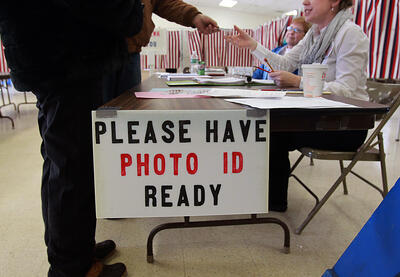This “Teach This” discussion guide centers on three excerpts from Carol Anderson’s One Person, No Vote, adapted for young adult readers by Tonya Bolden. These passages look at the ways accusations of voter fraud were used to suppress the vote following the passage of the Voting Rights Act of 1965 (VRA).
The first excerpt, “The Lie of Voter Fraud,” details how two Black women in rural Alabama were punished following accusations of voter fraud in 1978. The next, “Shelby v. Holder,” explains the arguments behind the 2013 ruling that gutted the VRA. The third, “Voter ID Laws,” describes some laws passed following Shelby v. Holder and their impact on Black and Latinx Americans.
A note on teaching through a pandemic:
We recognize that not all educators will be sharing physical or virtual space with students this fall. Because of that, we’ve tried to design these discussion guides in ways that can easily work across classes, whether you’re meeting face to face, in a virtual classroom or through another remote learning schedule. We’re so grateful to you and all the educators doing extraordinary work in these extraordinary times.
Here’s how you might start.
1. Check Your Students’ Previous Knowledge
You might begin by learning what students know about voter suppression in the 20th century, especially before the VRA. If students aren’t familiar with the ways that Black voters were disenfranchised before 1965, for example, consider sharing the sample literacy test from this excerpt from One Person, No Vote. You might also try our “Teach This” discussion guide about voter suppression following Reconstruction. And you could share first-person accounts, like this StoryCorps text in which Theresa Burroughs explains to her daughter how hard it was for her to register to vote.
To understand the impact of Shelby v. Holder, students will need to understand the role of the Voting Rights Act of 1965 in curbing Jim-Crow-era voter suppression. They should especially understand the importance of preclearance and the role the VRA created for the federal government to approve changes to some states’ voting laws. You might have students read an excerpt of One Person, No Vote about the VRA or check out our “Teach This” discussion guide on the law.
Finally, to introduce the argument that accusations of voter fraud have long been used as tools of voter suppression—and to help students connect to current mistruths about the security of mail-in voting—you might share the PBS Frontline video “How Linking Mail-in Ballots With Voter Fraud Became a Political Tool.”
2. Read Together and Clarify Understanding
Read the excerpts “The Lie of Voter Fraud,” “Shelby v. Holder” and “Voter ID Laws” from One Person, No Vote: How Not All Voters Are Treated Equally, by Carol Anderson with Tonya Bolden.
If students are working asynchronously, you may want to provide these questions to help them focus their learning as they read. If you’re meeting with students, try having them work individually, in pairs or in a group to answer a few text-dependent questions.
“The Lie of Voter Fraud”
- The authors strongly suggest that Wilder and Bozeman did not receive a fair trial. What evidence in the text would back up that idea?
- According to civil rights attorney Hank Sanderson, what is the impact of voter fraud prosecutions?
“Shelby v. Holder”
- This passage opens with a description of the VRA by Supreme Court Chief Justice Earl Warren. How would you describe the VRA in your own words?
- The excerpt lays out four arguments used to justify the decision in Shelby v. Holder. In your own words, what are these arguments?
“Voter ID Laws”
- What arguments are the authors making about the impact of voter ID laws?
- What evidence might support one Wisconsin judge’s argument that the state’s voter ID efforts were a “wretched failure”?
3. Talk Together
The following questions can help students connect the ideas in the three passages to unpack the argument that allegations of voter fraud can be a form of voter suppression.
- In “Shelby v. Holder,” Anderson and Bolden lay four common arguments against the VRA. Review the following arguments, and consider: What evidence in the excerpts supports this argument? What evidence in the excerpts works against it?
- “The VRA had been a success and so was no longer needed.”
- “The VRA picked on the South.”
- The VRA stopped states from preventing voter fraud.
- In “The Lie of Voter Fraud,” Anderson and Bolden quote the sheriff of Pickens County, Alabama, including his claim that “We treat [Black people] right.” Review that passage. Why do you think the authors included these quotes? How do they help you better understand the authors’ argument about the relationship between accusations of voter fraud and voter suppression?
- One Person, No Vote: How Not All Voters Are Treated Equally was published in the fall of 2019. What connections can you make to the arguments about voter fraud we hear today? How do you think the threat of voter fraud has made voting easier or harder for Americans?
For additional discussion guides, recommended lesson plans, PD and more, check out TT’s Future Voters Project.
